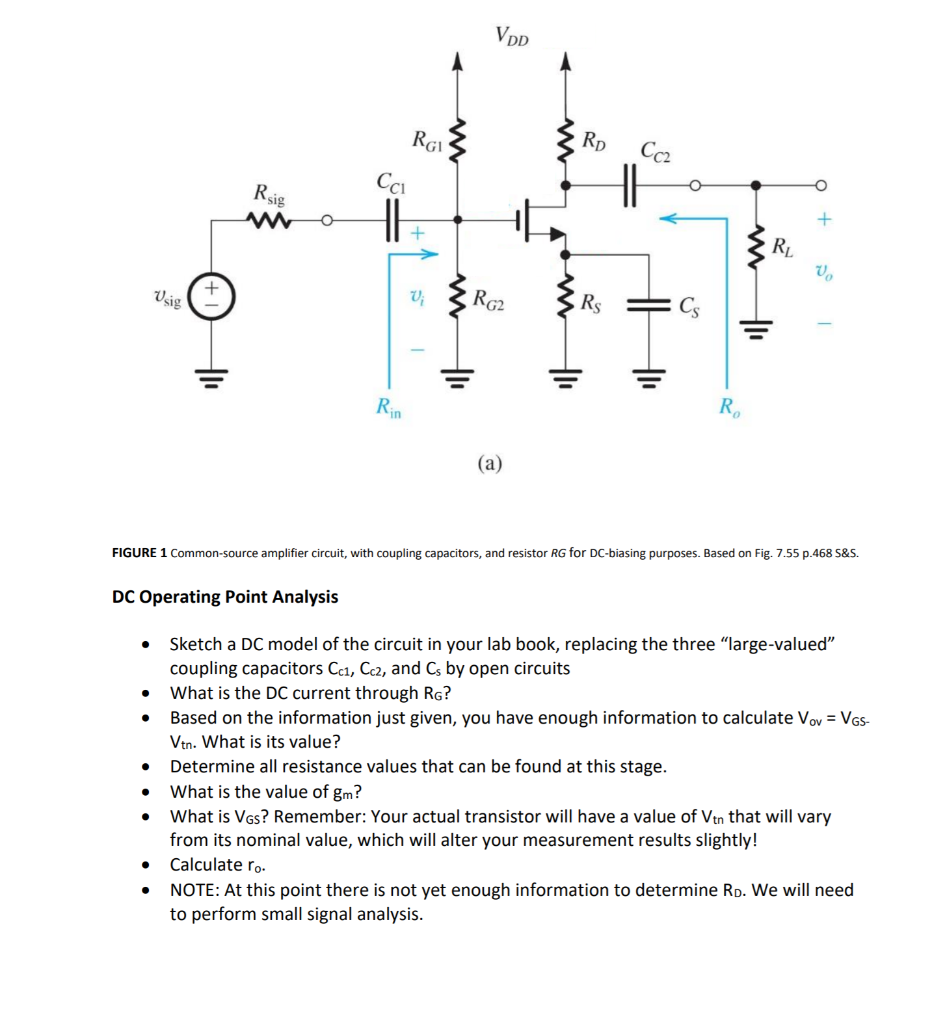Answered step by step
Verified Expert Solution
Question
1 Approved Answer
AC Analysis Sketch a small-signal model of the circuit in your lab book, replacing the transistor with its small-signal model, replacing the capacitors with



AC Analysis Sketch a small-signal model of the circuit in your lab book, replacing the transistor with its small-signal model, replacing the capacitors with short circuits (what happens to Rs?), and replacing VDD with an AC ground. Label the gate of the transistor as v, i.e., the small- signal voltage at the input. What is the ratio vo/Vsig? How would you approximate it in further calculations? Derive an expression for small signal gain. What is the value of Rp that produces a small- signal voltage gain of at least - 5 V/V? What is the DC voltage at the drain? Does this satisfy the assumption that the transistor should be operating in the saturation region? Explain. What is the output resistance, Ro? Show your work for calculating the output resistance. Simulation Simulate your circuit. Use capacitor values Cc1 = Cc2 = Cs = 47 uF (these values are large enough for coupling capacitors in this circuit), The values of Rs and RD based on your preceding calculations. Use a 10 mVpk_pk, and a 1-kHz sinusoid with no DC component applied at Vsig. Firstly, run a DC simulation to confirm that the DC currents and voltages are consistent with your hand calculations. This is important to ensure that the transistor is biased properly and operating in the expected operation region. From your simulation, report the DC values of VGS, VDs, and l. How closely do they match your calculations? Next, run a transient simulation to observe the sinusoidal input with respect to time. Determine the small signal voltage gain, Av, of your circuit. How closely does it match expectations? What information can you take away from Be sure to include all supporting information from simulations (plots, measurement, etc.) Table 1: Given Design Parameters Parameter Value 15V 50 VDD Rsig R RG1 ID 1mA | Av|=|Vo/Vsig | >= |-5V/V| = RG2 10kQ 10 Table 2: Transistor Hand Analysis Values Parameter Vtn UnCox (W/L) VA Value 0.71V 4.5mA/V 80V Usig Rsig www O CC1 Rin RGI VDD Vi RG2 +1 (a) 1 RD Cc Rs +1 1 Ro FIGURE 1 Common-source amplifier circuit, with coupling capacitors, and resistor RG for DC-biasing purposes. Based on Fig. 7.55 p.468 S&S. RL DC Operating Point Analysis Sketch a DC model of the circuit in your lab book, replacing the three "large-valued" coupling capacitors Cc1, Cc2, and C, by open circuits What is the DC current through RG? Based on the information just given, you have enough information to calculate Vov = VGS- Vtn. What is its value? + Vo Determine all resistance values that can be found at this stage. What is the value of gm? What is VGs? Remember: Your actual transistor will have a value of Vtn that will vary from its nominal value, which will alter your measurement results slightly! Calculate to. NOTE: At this point there is not yet enough information to determine RD. We will need to perform small signal analysis.
Step by Step Solution
★★★★★
3.53 Rating (174 Votes )
There are 3 Steps involved in it
Step: 1
Here are the stepbystep workings 1 Smallsignal model of the circuit Replace transistor w...
Get Instant Access to Expert-Tailored Solutions
See step-by-step solutions with expert insights and AI powered tools for academic success
Step: 2

Step: 3

Ace Your Homework with AI
Get the answers you need in no time with our AI-driven, step-by-step assistance
Get Started


